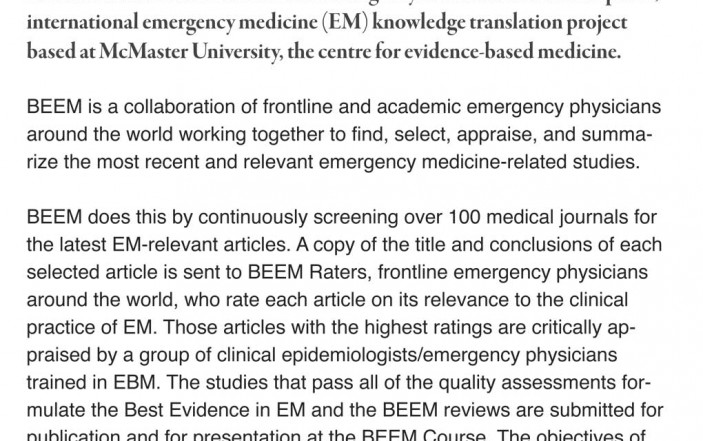You are working a busy ED shift at your hospital, when a 68-year-old female presents with a two-day history of a swollen and sore left calf. The patient has no venous thromboembolic risk factors or trauma history. Your physical examination reveals a well-appearing, afebrile patient with a normal neurovascular exam and no associated cellulitis. Confronted with a differential diagnosis of DVT, phlegmasia cerulea dolens, ruptured Baker’s cyst or occult soft tissue injury, how do you proceed?
The Setup:
You are working a busy ED shift at your hospital, when a 68-year-old female presents with a two-day history of a swollen and sore left calf. The patient has no venous thromboembolic risk factors or trauma history. Your physical examination reveals a well-appearing, afebrile patient with a normal neurovascular exam and no associated cellulitis. Confronted with a differential diagnosis of DVT, phlegmasia cerulea dolens, ruptured Baker’s cyst or occult soft tissue injury, how do you proceed?
The Choice:
All of the radiologists are attending a BMW conference (i.e. you do not have immediate access to formal ultrasound). Do you:
1) Phone the car dealership and convince a radiologist to come in to perform an after-hours study to exclude DVT
2) Start the low molecular weight heparin and arrange outpatient ultrasonography tomorrow
3) Calculate the patient’s risk of DVT and determine whether you can use a D-dimer assay to exclude the DVT
4) Perform (yourself) emergency department compression ultrasonography to exclude DVT?
 A large, prospective, randomized trial recently demonstrated that 2-point compression ultrasonography (plus D-dimer testing to determine the necessity of one week follow-up compression ultrasonography) has the same diagnostic accuracy as whole-leg color Doppler ultrasonography to diagnose DVT. In that study, compression was assessed at the common femoral vein in the groin and the popliteal vein in the popliteal fossa. However, all studies were performed in sonography labs by ultrasound technicians, not emergency physicians. Can the diagnostic accuracy of this rapidly performed test, using ultrasound equipment and probes readily available in the ED, be duplicated by emergency physicians? One recent systematic review opined “YES!” However, this systematic review may lack generalizability to the broader EM community. The studies included involved emergency physicians with special interest and training in focused ED ultrasound. Thus, their diagnostic accuracy may reflect greater expertise than is typical of the EM community as a whole.
A large, prospective, randomized trial recently demonstrated that 2-point compression ultrasonography (plus D-dimer testing to determine the necessity of one week follow-up compression ultrasonography) has the same diagnostic accuracy as whole-leg color Doppler ultrasonography to diagnose DVT. In that study, compression was assessed at the common femoral vein in the groin and the popliteal vein in the popliteal fossa. However, all studies were performed in sonography labs by ultrasound technicians, not emergency physicians. Can the diagnostic accuracy of this rapidly performed test, using ultrasound equipment and probes readily available in the ED, be duplicated by emergency physicians? One recent systematic review opined “YES!” However, this systematic review may lack generalizability to the broader EM community. The studies included involved emergency physicians with special interest and training in focused ED ultrasound. Thus, their diagnostic accuracy may reflect greater expertise than is typical of the EM community as a whole.
Let’s get back to our article. Kline et al. attempted to answer whether choice #4 is a viable option. Using 183 self-referred ED patients (with a DVT rate of 15%), they compared the diagnostic accuracy of emergency physicians, fellows, supervised residents and supervised midlevel ED providers performing 3-point (common femoral, superficial femoral, popliteal vein) compression ultrasonography versus whole-leg ultrasonography performed by an ultrasound technologist and interpreted by a radiologist. Baseline training for participants included previous certification to perform both a focused first-trimester pelvic ultrasound and a focused abdominal sonograph for trauma. All participants completed a 1-hour didactic lecture and a 2-hour practical examination that included 5 proctored ultrasound exams.
The Bottom Line:
The diagnostic accuracy of non-expert, emergency physician-performed, 3-point compression ultrasonography is not sufficient to guide patient care.
This study demonstrated a sensitivity of 70% (95% CI 60-80%) and a specificity of 89% (95% CI 83-94%) to detect deep venous thrombosis. The likelihood ratio (LR) of a positive test was 6.5 (95% CI 3.8-10.7), while the LR of a negative test was 0.3 (95% CI 0.2-0.6).
The Caveats:
While compression ultrasonography in the ED is not ready for primetime, there are several promising findings in this study. First, when performing compression ultrasonography on patients with a low pretest probability of DVT (based on clinical gestalt), the diagnostic accuracy improved dramatically. Clinical assessment alone has demonstrated suboptimal ability to rule-in (positive LR 1.2-1.4) or rule-out (negative LR 0.21-0.64) DVT. Further research is required to clarify the role and means of using diagnostic probability in combination with ED ultrasound testing. Second, sonographic diagnostic accuracy increased significantly for each clinician after enrollment of the third patient. Increasingly, trial evidence confirms that with proper training and hands-on supervision, inexperienced emergency physicians can become proficient DVT sonographers. Thus, the described training and proctoring process needs to be revisited to ensure skill competency prior to independent practice. In addition, emergency physicians need to be confident that patients will comply with recommendations for follow-up confirmatory lower extremity Doppler exams which has been questionable in the past.
The Case Outcome:
Unfortunately, you realize that you can’t simply fire up your high frequency probe and quickly disposition your patient. Fortunately, you recall a previous BEEM review that described a diagnostic approach using a clinical score in combination with D-dimer testing. Search epmonthly.com for the BEEM analysis, and quickly develop a diagnostic plan for your patient.
Jonathan Sherbino, MD, MEd, FRCPC
BEEM (Best Evidence in Emergency Medicine) Faculty
Assistant Professor, Division of Emergency Medicine, McMaster University



